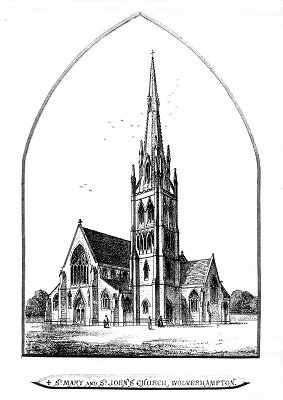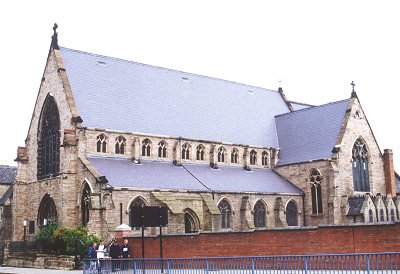The conflict within (part 3)
Ss Mary and John: strife with
the builder
It was the building of Ss Mary & John's Church on Snowhill which caused
the greatest conflict within the Catholic population of Wolverhampton.
One of the main protagonists in the troubles besetting the construction
of the new church was Richard Wullon, "a local Catholic builder whose
name is preserved in Wullon Street, Whitmore Reans". [Nicholls op cit p.
290].
| Wullon was an influential and respectable member of
Wolverhampton society, and in the early 1850s he was a member of the
Wolverhampton Board of Guardians. At the same time, when an appeal
was made for donations to help purchase the land on Snowhill, Wullon
gave £100, the largest single subscription. [List of subscribers for
Snowhill land Dec 1855].
It was not surprising, therefore, that after submitting a
reasonable estimate, he was awarded the contract to build the
church of SS Mary & John. Despite his being a Roman Catholic,
Richard Wullon was prepared to exploit his position and, in
consequence, this became the source of considerable antagonism. In an agreement signed with Bishop Ullathorne, Wullon promised
to build the Snowhill church "in a good and workmanlike manner"
for the sum of £3,428 and, unless the construction was impeded
by frost, the builder agreed that SS Mary & John's would be
completed by 1 November 1857. |

This artist's impression
shows a large tower and spire, which was never built. Why and
when this feature was abandoned is not known. |
In August 1852, Bishop Ullathorne was dismayed to receive a
communication from Wullon claiming that the latter had made errors in
his tender regarding both the quantities of materials required and the
costing of the materials, and warning that, as a result, the price would
be higher than that originally agreed. [Letter from Wullon to Ullathorne
1st Aug 1852] The new estimate was £3,965 [Letter from Wullon
to Ullathorne 30th dec1854] and this was bad news for Bishop
Ullathorne and the Catholics of Wolverhampton who were struggling to
raise the finance for the church building. The Bishop decided that money
might be saved if the planned wooden floor was replaced by one
constructed of stone, though this led to a row between him and the
architect, Charles Hansom, who pointed out that "wood might not be quite
so Gothic .... but it is much more comfortable, which is an important
consideration, for after all we ought to think of the comfort of the
people if they are to be made to visit the church frequently". [Letter
from Hanson to Ullathorne 17th Sept 1851] The Bishop
eventually won the argument and Wullon agreed to reduce the bill by £126
in consideration of this change and he subtracted a further £410 for
other alterations which Ullathorne agreed to make in the interests of
economy. It is interesting to note, however, that in response to the
Bishop’s request to increase the height of the chancel arch, Wullon
added £410 on to the bill which brought the total to £3,838.
 |
The Church of Ss Mary and
John, Snow Hill, today, after restoration. Note the
buttresses and side door where the tower would have been. |
Apart from there being difficulties with Richard Wullon over the cost
of the project, there were criticisms regarding the quality of the
materials he used, in particular the stone that he intended to obtain
from the quarry of his good friend, Mr Holyoake. When Bishop Ullathorne
sent Rev Estcourt to Wolverhampton in February 1852, to see how the
building was proceeding, the priest discovered that "Mr Wullon is merely
purchasing rough buns for walling whilst he has contracted to build the
whole with good stone". Estcourt went on to describe the walling stone
that Wullon was buying from Holyoake as "soft and rubbishy", and warned
that as a result of different stone being used, the finished building
"might well look like a patchwork". [Letter from Rev Estcourt to Hanson
17th Feb 1852] During the same month, Charles Hansom visited
the site and was horrified to find that Wullon was not using burrs or
walling stone but, instead, was breaking up blockstone. [Letter from
Hanson to Holyoake 20th Feb 1852] Wullon was ordered to abide
by the terms of the contract and to use only genuine "wallers"
henceforth. [Letter from Hanson to Ullathorne 21st Feb 1852].
The promise that Wullon had made to complete the building by November
1852, subject to there being no problems with frost, was also broken;
the church was not ready for opening until the spring of 1855. The
Catholics of Wolverhampton were lucky, perhaps, that Wullon finished
their church at all, for on Tuesday 23 March 1858 he was declared
bankrupt and, in order to pay off his many creditors, it was announced
that there would be an unreserved sale of his house contents and
stockin-trade at the end of the same month. [WC 24th Mar
1858] Wullon had anticipated this calamity and had travelled secretly to
Liverpool on Saturday 6th
March, from whence he had boarded the steamship "Arabia" which was bound
for America. Before his departure from Wolverhampton, he had gathered
together as much cash as possible, denying his creditors anything other
than a few packages that were later, seized by the Liverpool police. [17th
march 1858].
The downfall and hasty departure of Wullon came as a sad shock, though
not as a complete surprise, to the Catholic population of Wolverhampton.
Many considered that he had not only played an ignominious part in the
affair of the building of the new church, but that he had let down the
Catholic community by his actions and his apparent betrayal of trust.
[Letter to the Catholics of Wolverhampton from "Justica" 9th
June 1855].
|

